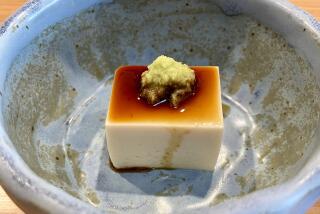DANCE REVIEW / L.A. FESTIVAL : ‘Blue Meteorite’ Offers a Stylized Twist on <i> Butoh</i>
- Share via
Fey, virtuosic, arduous,dreamily high-flown, coldly task-oriented, deliberately derivative and too self-consciously arty for its own good, “Blue Meteorite” supposedly represents the flip side of the astringent Japanese dance style known as butoh .
The hourlong piece by Saburo Teshigawara, performed at the Japan America Theatre on Thursday night, features the choreographer and three members of his company, Karas, moving in a dreamscape furnished with a blue-painted wall, a facing wall of glass panes and a rug of glass shards.
The manner of moving is a wonder to behold. Teshigawara--in whiteface, a white shirt, pants and black jazz shoes--keeps his legs in a perpetual state of turned-in, soft-kneed, weighted flexibility so that his upper torso can pivot and slide in seemingly any direction, even when he is on half-toe. The effect is almost as if he were able to rotate his body inside his skin.
He tilts; his arms slice the air; he falls; he recovers with the automatic precision of an android--and he falls and falls again. His face is frozen in distress as he executes his puppetlike routines to an uncredited sound score that begins quietly with small purrs and low machine sounds and swells to a stern tattoo of drums.
Kei Kei Miyata, Shun Ito and Koichi Ienaga observe all this from their slumped positions within individual ceremonial frames. Eventually they embark on a rhythmically varied, punishing set of perfect falls and automatic recoveries.
Teshigawara becomes a latter-day incarnation of Nijinsky’s Faun--to the taped accompaniment of Debussy’s “Prelude to the Afternoon of a Faun”--as he stretches and balances on the glass shards. Seeing his reflection, he twitches with animal pleasure and reproduces the bolt upright seated posture and mittenlike gesture of the original choreography.
The program statement says the glass is a symbol of “crystals of light and fragments of time.” But while the faun experiences disembodied bliss, the audience feels empathetic pain for a real dancer lying on sharp glass, giving the proceedings an ever-so-controlled aura of masochism.
Teshigawara’s transformation from man to spirit is now complete. He flutters and jumps and flashes his faun-hands, joins in a stomping line dance with the others and flirts with the wall of glass. At the end, he makes tiny, nearsighted writing motions in the air.
The gesture recalls the crabbed movements of butoh --as if, in his white-light ecstasy, Teshigawara is honoring the older dance form. But his version is a postmodern mutant--coolly appropriating famous choreography and organizing co-performers into a robotic, backup-dancer look not far removed from pop music video. A technically brilliant, fine-tuned glibness has replaced the flinty power of butoh .
Performances continue through Sunday.
More to Read
The biggest entertainment stories
Get our big stories about Hollywood, film, television, music, arts, culture and more right in your inbox as soon as they publish.
You may occasionally receive promotional content from the Los Angeles Times.










